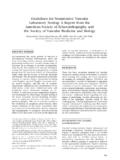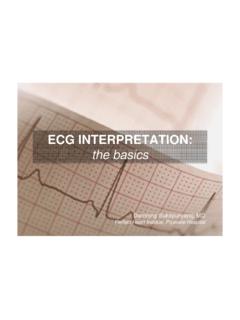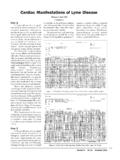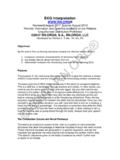Transcription of Takotsubo Cardiomyopathy - - RN.org®
1 Takotsubo Cardiomyopathy Reviewed December, 2015, Expires December, 2017 Provider Information and Specifics available on our Website Unauthorized Distribution Prohibited 2015 , , , LLC By Cynthia R. Bascara, APN-C, MSN, CCRN Objectives: At the end of session, the participation will be able: 1. To define and state etiology of Takotsubo Cardiomyopathy . 2. To differentiate manifestations of Takotsubo Cardiomyopathy with classic myocardial infarction. 3. To define Mayo Clinic s proposed diagnostic criteria for Takotsubo Cardiomyopathy . 4. To verbalize the complications of Takotsubo Cardiomyopathy . 5. To state the similarity and difference between the treatment of Takotsubo Cardiomypathy and myocardial infarction.
2 6. To state the nursing care of patients diagnosed with Takotsubo Cardiomyopathy . Definition Takutsobo Cardiomyopathy is spontaneous reversible form of Cardiomyopathy that is often induced by emotional or physical stress. It is characterized by transient apical left ventricular (LV) dysfunction in the absence of significant coronary artery disease (CAD). The LV abnormality reverses spontaneously in days or weeks. Other terminologies used are: Stress-induced Cardiomyopathy Stress-related Cardiomyopathy Apical ballooning syndrome (ABS) Ampulla Cardiomyopathy Neurogenic myocardial stunning Pathophysiology: There are still on-going research studies to find out the true etiology of Takotsubo Cardiomyopathy .
3 However the following are theories that may be associated with the condition: Excessive exposure to catecholamines mediated by exaggerated sympathetic response. On the role of catecholamines, is it the high levels of epinephrine, norepineprine and dopamine or is the patient s higher sensitivity to cathecholamine that contribute to the condition are the questions the researchers are still trying to find out. Coronary artery spasm which can cause ischemia in the absence of obstructive coronary artery disease (CAD). Transient occlusion by atherosclerotic plaque. Takotsubo Cardiomayopathy is sometimes called an aborted myocardial infarction . In Takotsubo Cardiomayopathy, the area of affected myocardium is much larger than the normal distribution of a single coronary artery.
4 Higher prevalence in women predominantly in post menopausal: mean age: 68 years old. The following research questions and studies come up with this theory: Does a difference exist between the sexes in the psychological response to stress that triggers an abnormal physiological change? See Table 1. Is the cardiovascular system of women physiologically or anatomically more sensitive than that of men to catecholamines? Sex hormones may influence the sympathetic nervous system and may affect vasoreactivity or the tendency to spasm. Perhaps endothelial dysfunction, known to worsen after menopause (because of lowered estrogen levels) further increases vulnerability to sympathetically mediated myocardial stunning.
5 Table I. Emotional and physical stressors associated with Takotsubo Cardiomyopathy Emotional stressors Unexpected death of relative or friend Domestic abuse Confrontational argument Catastrophic medical diagnosis Armed robbery Gambling losses Surprise party Surprise reunion Car accident Fear of procedure Fear of choking Court appearance Public performance Physical stressors Exacerbated systemic disorders Noncardiac invasive procedures Exhausting physical effort Asthma attack Pneumothorax Ventricular fibrillation Cold Exposure Proposed Diagnostic Criteria (Mayo Clinic) Transient hypokinesis, akinesis, or dyskinesis of the left ventricular mid segments with or without apical involvement Absence of obstructive coronary disease or angiographic evidence of acute plaque rupture New electrocardiographic abnormalities (either ST- segment elevation and/or t wave inversion)
6 Or modest elevation in cardiac troponin Absence of pheochromocytoma or myocarditis Clinical Findings to assist in Diagnosis Sudden onset of chest pain or shortness of breath Precipitant physical or emotional stress Electrocardiographic changes suggestive of acute MI Mild to moderate elevation of cardiac biomarkers Typical octopus pot morphology on echocardiogram or left ventriculogram No evidence of obstructive CAD on cardiac catheterization Complete resolution of LV dysfunction weeks after event Hypokinesis of Left Ventricle Octopus Trap in Japanese (Tako-tsubo) ( , 2011) Reported complications: LV failure with or without pulmonary edema Cardiogenic shock LV outflow tract obstruction (LVOT).
7 LVOT is the path that blood takes along the septal wall as the blood is being ejected from the left ventricle through the aortic valve. LVOT obstruction is caused by exaggerated contraction of the base of the ventricle when hypokinesis occurs leading to unbalanced contraction; reduction of outflow tract size; accelerated blood flow through this pathway during systole and decrease in pressure above neighboring mitral valve. These changes cause suctioning effect of anterior mitral valve (MV) leaflet toward septum (systolic anterior motion of the MV leaflet) leading to more LVOT obstruction causing hypotension. MR from systolic anterior motion Ventricular arrythmias Transient complete AV block LV mural thrombus LV free wall rupture Death Treatment Initial management is largely supportive, including hydration and attempt to alleviate triggering physical or emotional stress.
8 Some may need use of standard medications for heart failure due to systolic dysfunction. In patients who present with a picture of ST-elevated myocardial infarction (STEMI), the patients may need urgent catheterization and Percutaneous Coronary Intervention (PCI) or with fibrinolytic therapy For stable patients diagnosed with Takotsubo Cardiomyopathy , following are recommended: Beta blocker Patients with LVOT, ace inhibitor or an angiotensin receptor blocker Patients with heart failure who do not have LVOT, diuresis Aspirin in presence of coexisting coronary atherosclerosis If diagnosis is made, ASA can be discontinued unless CAD or Peripheral Vascular Disease (PVD) is concomitant.
9 Beta Blockers may be continued long-term to protect against catecholamine sensitivity which may predispose to this syndrome. Heparin and Coumadin should be used if atypical thrombus is present, or a severe apical defect makes thrombus formation likely. For patients with hypotension and shock, recommendations will also be discussed. The causes of hypotension and shock in Takotsubo Cardiomyopathy are severe systolic dysfunction and LVOT obstruction. Urgent echocardiography is necessary to determine presence of LVOT. In patients with hypotension, whether with or without significant LVOT obstruction, if no significant pulmonary congestion is present, cautious fluid resuscitation is recommended (Grade 2C) In patients with hypotension who do not have significant outflow obstruction, intravenous inotropes such as dopamine In patients with hypotension and moderate-to-severe LVOT obstruction, inotropic agents are not recommended because they can worsen the degree of obstruction (Grade 2C).
10 In patients with hypotension and moderate-to-severe LVOT obstruction, beta blockers are recommended. Beta blockers can improve hemodynamics by causing resolution of the obstruction (Grade 2C). For patients who cannot tolerate or do not adequately respond to beta blockers, an alpha agonist may be added with caution and close monitoring. Nursing Care Health care providers should be prepared to provide education and counseling for those patients who exhibit signs and symptoms of acute coronary syndrome but appear to be at low risk for coronary artery disease; especially if a stressful event occurred before the onset of signs and symptoms. Nursing care involves hemodynamic monitoring, providing supportive measures, and watching for complications.
















